Monster Hunter World multiplayer offers thrilling cooperative gameplay where players can team up to face formidable monsters. Explore diverse weapon choices, including swords and bows, each with unique abilities. Learn effective strategies for tackling popular monsters like Rathalos and Nergigante, while emphasizing teamwork and communication for a successful hunt. Mastering these elements enhances your multiplayer experience and boosts your chances of victory.
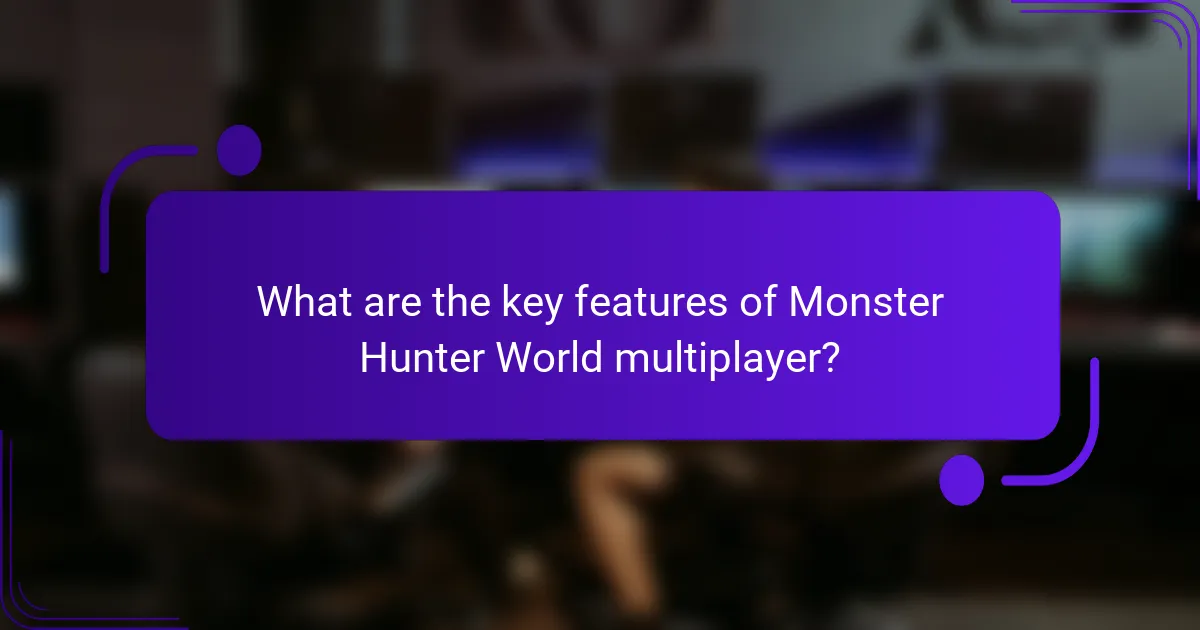
What are the key features of Monster Hunter World multiplayer?
Monster Hunter World multiplayer features cooperative gameplay, diverse weapon choices, and strategic monster encounters. Players can team up in groups of up to four hunters to tackle formidable monsters, utilizing unique weapons like swords, bows, and hammers, each with distinct abilities. The variety of monsters, such as Rathalos and Nergigante, offers unique challenges requiring different strategies. Communication and coordination among players enhance the experience, making teamwork essential for success.
How does the multiplayer experience differ from single-player?
The multiplayer experience in Monster Hunter World emphasizes teamwork and strategy, unlike the solitary focus of single-player. In multiplayer, players can coordinate weapon types and tactics to tackle formidable monsters more efficiently. This collaborative approach allows for diverse strategies, such as combining elemental attacks or utilizing traps, enhancing the overall gameplay dynamic. Additionally, multiplayer sessions often feature larger monster health pools, requiring synchronized efforts to succeed. The unique attribute of multiplayer is the social interaction, fostering camaraderie and shared achievements among players.
What platforms support Monster Hunter World multiplayer?
Monster Hunter World multiplayer is supported on PlayStation 4, Xbox One, and PC. Each platform allows players to team up for cooperative hunts, enhancing the gameplay experience. Cross-play is not available, so players must use the same platform to join each other. The game features various multiplayer modes, including quests and events that require teamwork to defeat powerful monsters.
Which multiplayer modes are available?
Monster Hunter World offers several multiplayer modes, including online co-op, local co-op, and SOS flares. Players can team up to tackle challenging monsters, share resources, and strategize together. The online co-op mode allows players to join quests with friends or other hunters, enhancing the gameplay experience. Local co-op enables players to hunt alongside friends in the same physical location. SOS flares allow players to request assistance from others when facing tough monsters, promoting community collaboration.
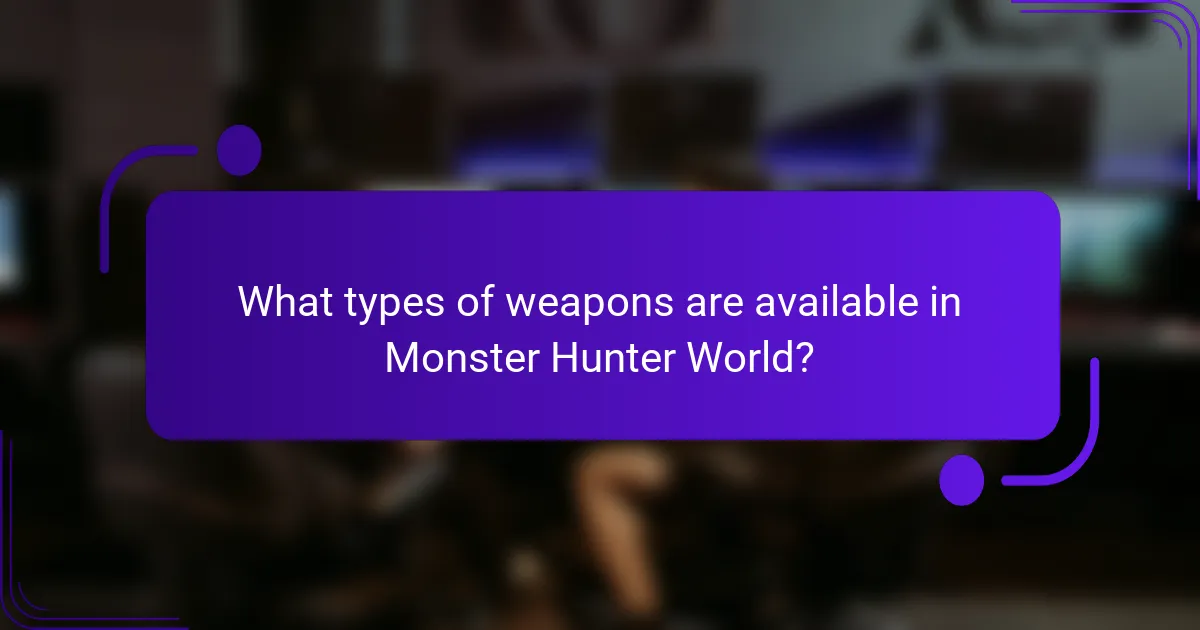
What types of weapons are available in Monster Hunter World?
In Monster Hunter World, players can choose from 14 weapon types, each with unique playstyles and mechanics. These weapons include Great Sword, Long Sword, Sword and Shield, Dual Blades, Hammer, Hunting Horn, Lance, Gunlance, Switch Axe, Charge Blade, Bow, and two types of ranged weapons: Light Bowgun and Heavy Bowgun. Each weapon type offers distinct attributes, such as attack speed, damage output, and elemental capabilities, allowing players to tailor their approach to hunting monsters effectively.
How do weapon types influence gameplay strategies?
Weapon types significantly shape gameplay strategies in Monster Hunter World. Different weapons offer unique mechanics, damage types, and playstyles that influence team dynamics and monster tactics.
For instance, heavy-hitting weapons like great swords require players to time their attacks carefully, while faster weapons like dual blades allow for rapid strikes and mobility. This diversity encourages players to adopt complementary roles within a team, enhancing overall effectiveness against various monsters.
Additionally, weapon attributes such as elemental damage can exploit monster weaknesses, further impacting strategy. Players must consider both their weapon’s strengths and the monster’s vulnerabilities to optimize their approach.
Ultimately, understanding how weapon types influence gameplay strategies is crucial for success in multiplayer hunts. Players who adapt their strategies based on weapon characteristics and team composition can significantly improve their hunt outcomes.
What are the top weapons favored by players in 2025?
In 2025, players favor the Great Sword, Long Sword, and Bow in Monster Hunter World Multiplayer. Each weapon offers unique playstyles and strategies.
The Great Sword excels in raw damage and powerful charged attacks. The Long Sword provides swift strikes and excellent mobility with its Spirit Blade mechanic. The Bow allows for ranged combat, enabling players to maintain distance while dealing damage.
Players choose these weapons for their versatility and effectiveness against various monsters, enhancing the multiplayer experience.
How can players effectively switch between weapon types?
Players can effectively switch between weapon types by mastering the controls and understanding each weapon’s strengths. Familiarize yourself with the unique mechanics of each weapon, as this allows for seamless transitions during combat. Practice switching during low-pressure situations to build confidence. Use the game’s training area to refine skills and experiment with different combinations. Timing is crucial; switch weapons when the opportunity arises, especially after dodging or when an enemy is vulnerable. Stay aware of your surroundings to make quick decisions on which weapon to use for maximum efficiency.
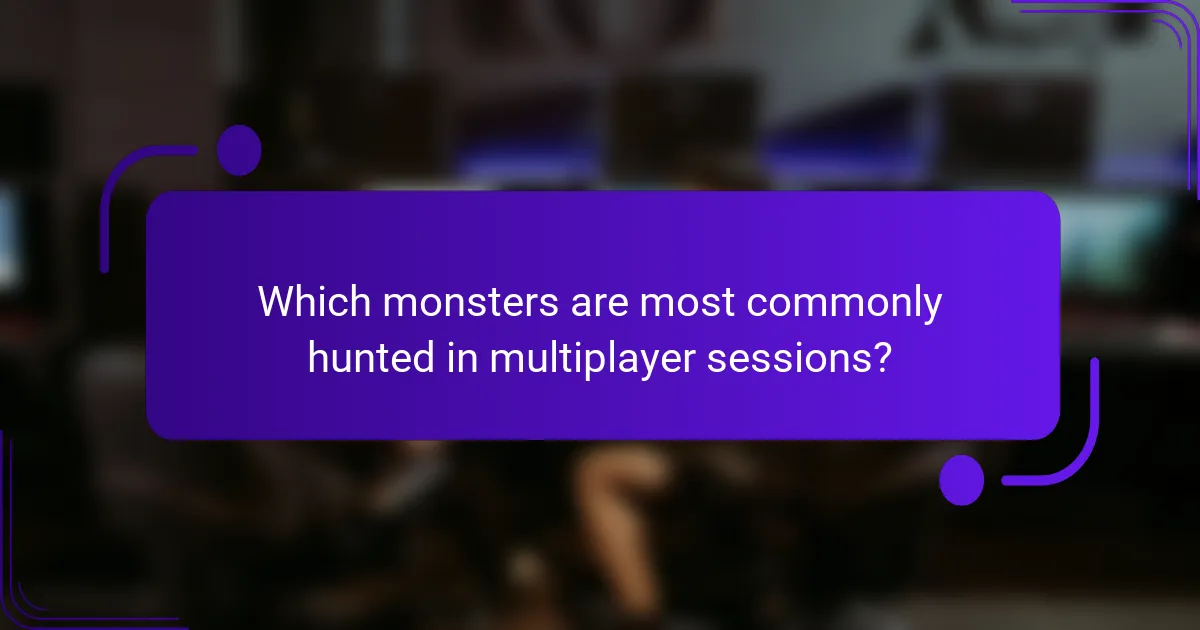
Which monsters are most commonly hunted in multiplayer sessions?
In multiplayer sessions of Monster Hunter World, the most commonly hunted monsters include Rathalos, Nergigante, and Diablos. These creatures are popular due to their challenging gameplay and valuable rewards. Rathalos, known for its aerial attacks, offers unique crafting materials. Nergigante, a unique Elder Dragon, is sought for its powerful gear upgrades. Diablos, with its rare attributes, is favored for its aggressive nature and distinctive horn materials. Players often strategize around these monsters for effective team play and resource gathering.
What are the strengths and weaknesses of popular monsters?
Popular monsters in Monster Hunter World possess distinct strengths and weaknesses that shape gameplay strategies.
| Monster | Strengths | Weaknesses |
|——————–|————————————-|————————————-|
| Rathalos | High mobility, powerful attacks | Vulnerable to ice attacks |
| Nergigante | Regenerates health quickly | Weak to dragon damage |
| Diablos | Strong charging attacks | Weak to water damage |
| Anjanath | High damage, strong physical defense| Weak to ice and dragon damage |
| Bazelgeuse | Aerial attacks, explosive damage | Weak to thunder damage |
| Tigrex | Aggressive behavior, strong melee | Vulnerable to paralysis and sleep |
Understanding these attributes allows players to tailor their strategies effectively in multiplayer scenarios.
How do monster behaviors change in multiplayer encounters?
Monster behaviors become more aggressive and strategic in multiplayer encounters. They adapt to the number of hunters, altering attack patterns and targeting players more frequently. This change enhances the challenge, requiring coordinated strategies among players. For example, some monsters may use area attacks to hit multiple targets, forcing players to spread out. Additionally, monsters may become more evasive, utilizing the environment to escape or reposition. Understanding these dynamics is crucial for effective teamwork and successful hunts.
What strategies work best against specific monsters?
Effective strategies against specific monsters in Monster Hunter World depend on their unique attributes. Understanding each monster’s weaknesses enhances your chances of success.
1. For Rathalos, use ranged weapons like bows or guns to exploit its weak spots.
2. Against Diablos, focus on breaking its horns with blunt weapons to reduce its charge attacks.
3. When facing Nergigante, utilize traps and status effects to immobilize it during its aggressive phases.
4. For Kushala Daora, elemental weapons like fire can counter its wind barrier.
5. Against Behemoth, coordinate with teammates to manage its mechanics and use elemental weaknesses effectively.
These strategies leverage each monster’s unique attributes, ensuring a higher success rate in multiplayer encounters.
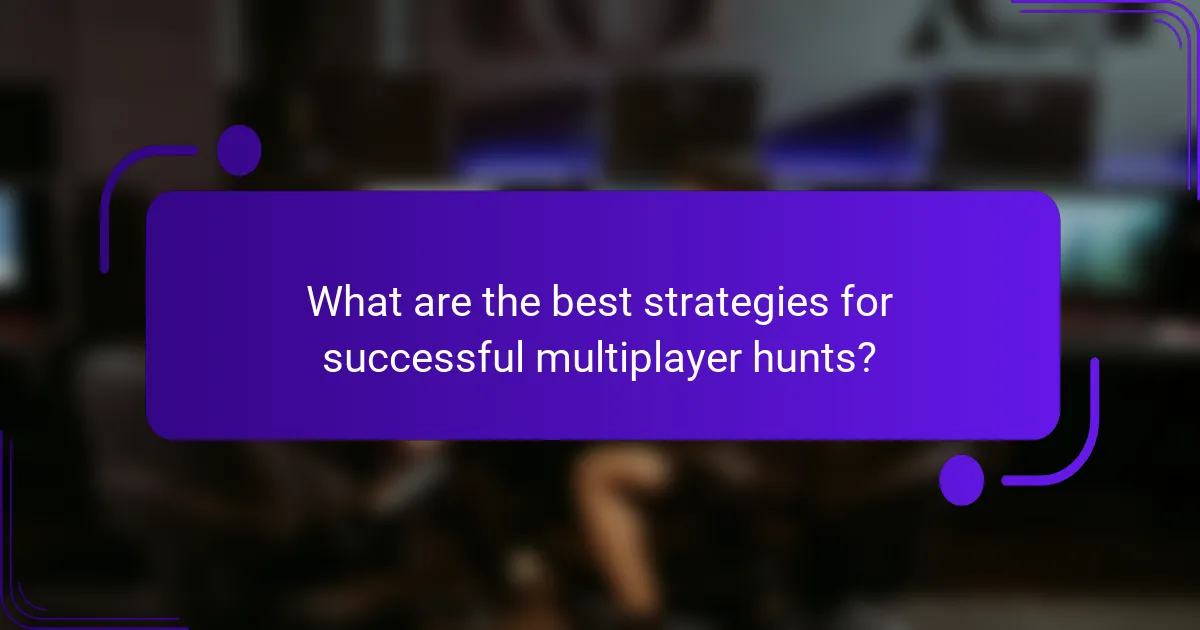
What are the best strategies for successful multiplayer hunts?
Effective multiplayer hunts in Monster Hunter World require teamwork, strategic weapon choices, and understanding monster behaviors. Focus on communication, role specialization, and utilizing environmental advantages.
1. Coordinate roles: Assign specific tasks like tanking, damage dealing, or support.
2. Choose complementary weapons: Pair ranged and melee weapons for balanced offense.
3. Understand monster patterns: Learn attack patterns to anticipate and counter effectively.
4. Use traps and items: Employ traps and buffs strategically to control the hunt.
5. Stay mobile: Keep moving to avoid attacks and reposition for optimal damage.
How can team composition affect hunt outcomes?
Team composition significantly influences hunt outcomes in Monster Hunter World. A balanced mix of weapon types and roles enhances effectiveness against various monsters.
For example, a team with a tank, damage dealers, and support can maximize damage while ensuring survivability. Each weapon class offers unique attributes, such as range or status effects, which can exploit monster weaknesses.
Moreover, coordination and strategy among team members can lead to successful hunts. Effective communication allows for timely use of buffs and healing, increasing the chances of victory.
In summary, diverse team composition, strategic planning, and synergy among players are crucial for optimal hunt success.
What role does communication play in multiplayer hunts?
Communication is crucial in multiplayer hunts as it enhances teamwork and strategy execution. Effective communication allows players to share information about monster locations, health status, and attack patterns. This coordination increases the chances of success in defeating challenging monsters. Additionally, players can strategize weapon usage and item deployment, adapting to the unique attributes of each hunt. Clear communication fosters a more enjoyable and efficient hunting experience, ultimately leading to better rewards and progression in Monster Hunter World.
Which tactics are essential for tackling high-level challenges?
Essential tactics for tackling high-level challenges in Monster Hunter World multiplayer include strategic weapon selection, effective teamwork, and monster behavior understanding. Players should choose weapons that complement their roles, such as ranged for support or melee for frontline engagement. Coordination with teammates enhances efficiency, allowing for synchronized attacks and healing. Understanding monster patterns aids in anticipating movements, leading to successful hunts.
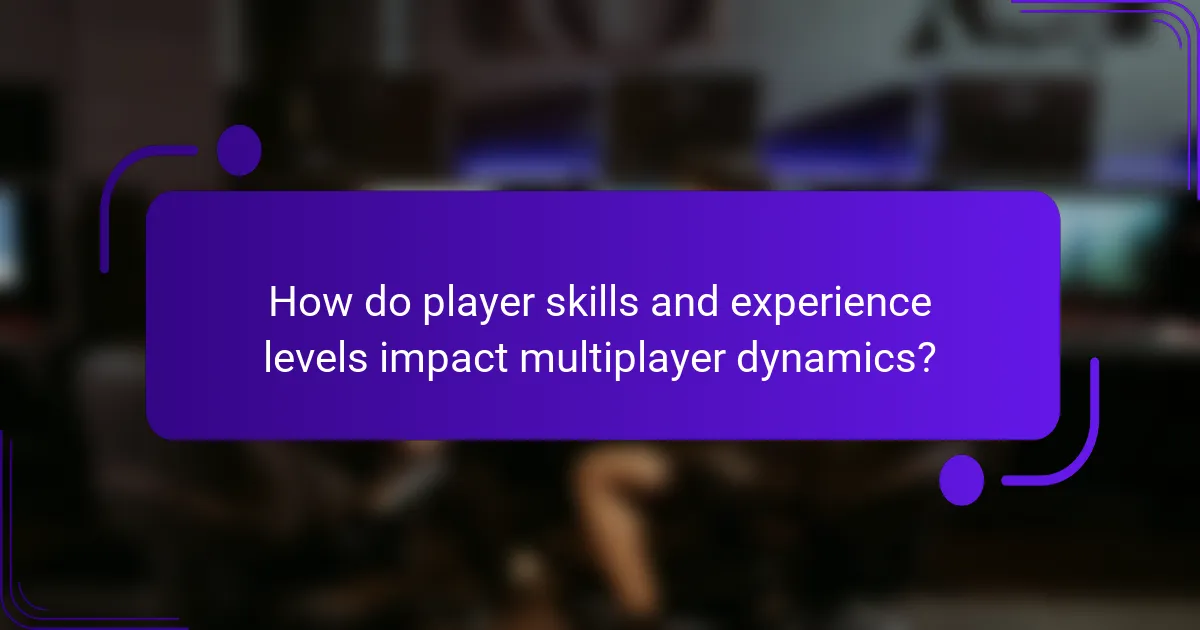
How do player skills and experience levels impact multiplayer dynamics?
Player skills and experience levels significantly influence multiplayer dynamics in Monster Hunter World. Experienced players often excel in weapon mastery, monster behavior understanding, and strategic planning. This proficiency enhances team coordination and effectiveness. Conversely, less experienced players may struggle with timing and resource management, which can hinder group performance.
Effective communication becomes crucial in mixed-skill teams. Skilled players can guide novices, fostering a collaborative environment. Additionally, the choice of weapons affects gameplay; some weapons require precise timing, while others are more forgiving. The synergy between different weapon types can enhance overall team dynamics, allowing for diverse strategies against monsters.
In summary, player proficiency shapes the multiplayer experience by affecting coordination, strategy, and communication. Balancing skill levels within a team can lead to more engaging and successful hunts.
What are common mistakes made by new players in multiplayer?
New players in Monster Hunter World multiplayer often make critical mistakes that hinder their performance. Common errors include ignoring team dynamics, overcommitting to solo play, and neglecting equipment upgrades.
Failing to communicate with teammates can lead to disorganized hunts, resulting in missed opportunities and increased difficulty. Many new players focus solely on their weapon without considering synergies with team members.
Another frequent mistake is not adapting strategies based on the monster’s behavior. Players may stick to a single tactic, which can be ineffective against certain monsters. Lastly, overlooking the importance of consumables, such as potions and buffs, can severely limit a player’s effectiveness in combat.
How can experienced players mentor newcomers effectively?
Experienced players can mentor newcomers effectively by providing guidance, sharing strategies, and fostering teamwork. They should focus on weapon mastery, monster behaviors, and cooperative tactics. Regularly engaging in quests together allows newcomers to learn through experience. Additionally, offering constructive feedback enhances skill development. Creating a supportive environment encourages questions and experimentation, leading to improved gameplay and confidence.
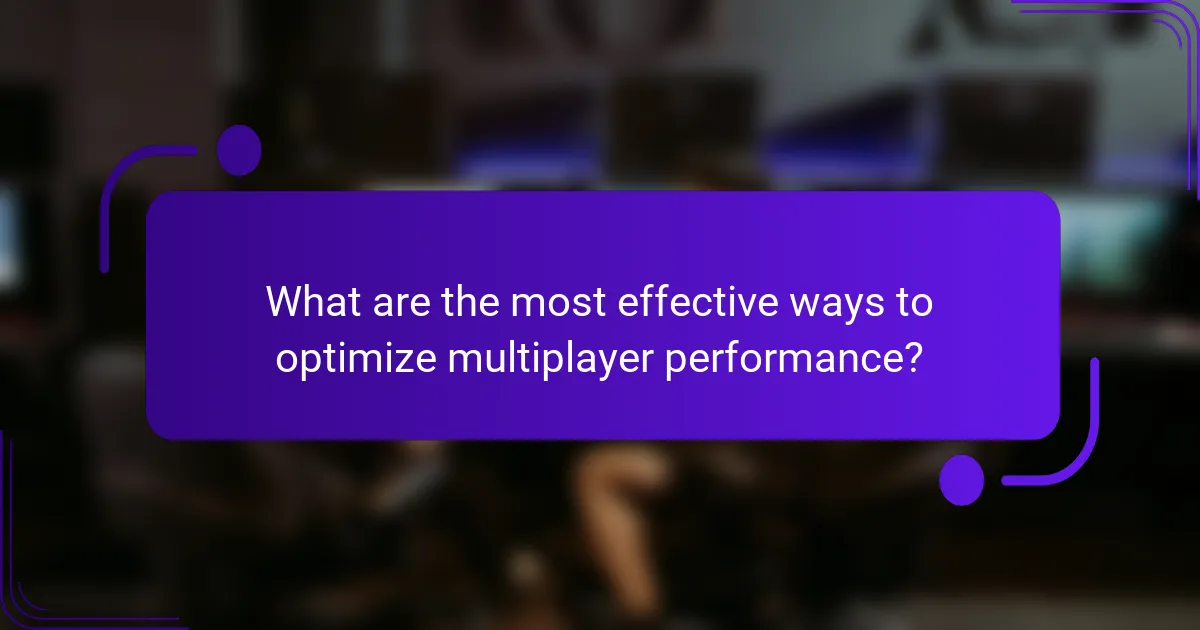
What are the most effective ways to optimize multiplayer performance?
To optimize multiplayer performance in Monster Hunter World, focus on communication, coordination, and weapon synergy. Effective strategies include using voice chat for real-time coordination, selecting complementary weapons to enhance team dynamics, and prioritizing monster targeting to streamline hunts.
Consider the following effective strategies:
1. Establish clear roles among players, such as damage dealers and support.
2. Use items strategically, like traps and buffs, to support the team.
3. Adapt to the monster’s behavior, ensuring everyone is aware of its attacks and weaknesses.
4. Regularly check each other’s health and status during combat to maintain team efficiency.
How can players manage resources during hunts?
Players can manage resources during hunts by prioritizing item usage, coordinating with teammates, and planning ahead. Efficient resource management involves using traps and ammo wisely, sharing items, and tracking monster behavior.
Preparation is crucial; players should bring potions, buffs, and traps that complement their team’s strategy. Communicating effectively ensures that resources are used optimally, reducing waste and maximizing effectiveness.
Additionally, understanding each monster’s weaknesses helps in deciding which items to use during the hunt. By focusing on these strategies, players can enhance their hunting efficiency and success rates.
What are best practices for coordinating with teammates?
Effective coordination with teammates in Monster Hunter World involves clear communication, role assignment, and strategy alignment. Establishing a designated leader can streamline decision-making. Regularly share information about monster behaviors and weapon strengths to enhance teamwork. Utilize in-game tools like voice chat for real-time updates and adjustments during hunts. This approach fosters collaboration and maximizes efficiency in multiplayer scenarios.
Which tools and apps enhance the multiplayer experience?
Several tools and apps enhance the multiplayer experience in Monster Hunter World. Discord is popular for voice communication, facilitating real-time strategy discussions. The Monster Hunter World Companion app provides essential information on weapons, monsters, and quests, improving coordination. Additionally, social media platforms like Reddit offer community insights and tips, enhancing gameplay. Lastly, Twitch and YouTube serve as platforms for viewing strategies and tutorials, enriching player knowledge and skills.
What are the common pitfalls to avoid in multiplayer hunts?
To succeed in multiplayer hunts, avoid common pitfalls that can hinder teamwork and efficiency. Prioritize communication, as misunderstandings can lead to ineffective strategies. Ensure everyone understands their weapon roles; mismatched loadouts can create imbalances. Avoid overcommitting to solo plays, which may isolate teammates. Lastly, be aware of monster behaviors; failing to adapt can result in missed opportunities for attacks.